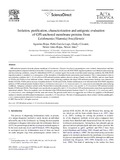Mostrar el registro sencillo del ítem
Isolation, purification, characterization and antigenic evaluation of GPI-anchored membrane proteins from Leishmania (Viannia) braziliensis
| dc.rights.license | http://creativecommons.org/licenses/by-nc-sa/3.0/ve/ | |
| dc.contributor.author | Rojas E., Agustina del V. | |
| dc.contributor.author | García Lugo, Pablo J. | |
| dc.contributor.author | Crisante R., Gladys E. | |
| dc.contributor.author | Añez Reverol, Nestor Oswaldo | |
| dc.contributor.author | Añez Rojas, Néstor | |
| dc.date.accessioned | 2009-11-11T22:32:15Z | |
| dc.date.available | 2009-11-11T22:32:15Z | |
| dc.date.issued | 2008 | |
| dc.identifier.uri | http://www.saber.ula.ve/handle/123456789/29806 | |
| dc.description.abstract | GPI-anchored proteins from the plasma membrane of Leishmania (Viannia) braziliensis promastigotes were isolated, characterized and their migration pattern compared with those from other Leishmania species. In all cases the SDS-PAGE migration patterns were obtained under reducing and non-reducing conditions, using DL-dithiothreitol (DTT) as a reducer agent. Our results reveal that under reducing conditions the SDS-PAGE migration pattern is modified as a consequence of the disruption of disulphur-bonds and protein transformation. This is demonstrated when in non-reducing conditions the L. (V.) braziliensis-GPI-anchored proteins pattern showed a group of bands over the 100 kDa, and two more bands of 52 kDa and 50 kDa in four different isolates, whereas under reducing conditions the major GPI-anchored protein fractions were detected as bands of 63 kDa, 50 kDa and an increase of peptides between 34 kDa and 22 kDa. Similar modifications were detected in the SDS-PAGE migration patterns of GPI-anchored protein fractions from L. (Leishmania) donovani, L. (L.) mexicana and L. (L.) amazonensis run under the same reducing conditions. Antigenic evaluation carried out by Western blot revealed the presence of two very specific L. (V.) braziliensis-GPI-anchored protein bands of 50 kDa and 28 kDa. These bands were specifically recognized by anti-L. (V.) braziliensis-GPI-anchored protein serum from experimentally immunized animals. These two peptides were not detected when GPI-anchored protein fractions from L. (L.) donovani, L. (L.) mexicana and L. (L.) amazonensis, were challenged with the same anti-serum. The present results lead us to suggest the use of these two peptides as biochemical markers to identify and differentiate leishmaniasis caused by L. (V.) braziliensis. The lack of immunogenicity observed here with the peptide gp63, a very common protein detected in Leishmania species, is considered. | es_VE |
| dc.language.iso | en | es_VE |
| dc.publisher | Acta Tropica 105 (2008) | es_VE |
| dc.rights | info:eu-repo/semantics/openAccess | |
| dc.title | Isolation, purification, characterization and antigenic evaluation of GPI-anchored membrane proteins from Leishmania (Viannia) braziliensis | es_VE |
| dc.type | info:eu-repo/semantics/article | |
| dc.description.colacion | 139-144 | es_VE |
| dc.description.email | agustinarojas@yahoo.com | es_VE |
| dc.description.email | pgarcial@ula.ve | es_VE |
| dc.description.email | gecr68@hotmail.com | es_VE |
| dc.description.email | nanes@ula.ve | es_VE |
| dc.description.email | njar@ula.ve | es_VE |
| dc.subject.facultad | Facultad de Ciencias | es_VE |
| dc.subject.keywords | GPI | es_VE |
| dc.subject.keywords | Membrane proteins | es_VE |
| dc.subject.keywords | L. (V.) braziliensis | es_VE |
| dc.subject.keywords | Biochemical marker | es_VE |
| dc.subject.tipo | Artículos | es_VE |
| dc.type.media | Texto | es_VE |


